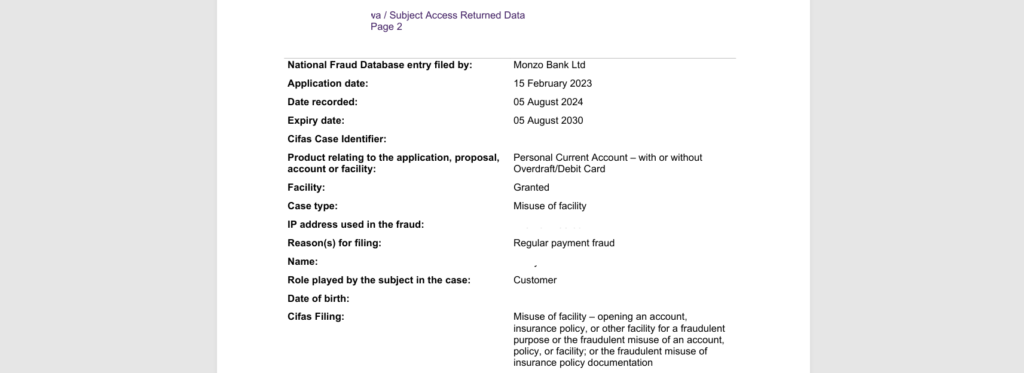This article explains the CIFAS marker removal process and key steps to take:
- What a Cifas Marker is
- Types of Cifas Markers
Explore the process of challenging and removing these markers with expert guidance from Cifasmarker.org, offering comprehensive support and expertise. If you’re facing the challenges of a CIFAS marker, find the solutions you need to move forward with confidence.
This article will delve into what CIFAS markers are, how to remove them, the cifas removal process and how Cifasmarker.org can assist you in navigating this complex process.
What Are CIFAS Markers?
CIFAS, which stands for Credit Industry Fraud Avoidance System, is a non-profit organization in the UK dedicated to preventing fraud. Banks and other financial institutions, such as insurance companies, report to CIFAS when they suspect fraudulent activity.
These reports, known as markers, serve as warnings to other institutions that a customer might pose a fraud risk.
CIFAS manages a large database of fraudulent conduct, and member organizations can access this database to check the risk associated with potential customers.
Once a cifas marker is added, you have to follow the cifas marker removal process to get the marker removed from your record.
Markers are categorized based on the type of suspected fraud, and they don’t typically appear on regular credit reports from agencies like Experian. This means many people are unaware they have a CIFAS marker until they face issues when applying for credit or banking services.
Types of CIFAS Markers
There are several types of CIFAS markers, each with specific criteria and durations, ranging from 13 months to six years:
- Protective Registration: This service is for individuals who believe they might be victims of fraud. It is a paid service and lasts for two years.
- Victim of Impersonation: This marker is for those who have been victims of identity fraud and lasts for 13 months.
- First Party Fraud: This occurs when there is no intention to repay a loan or credit obtained. It can remain on a person’s file for up to six years.
- Facility Takeover: When a fraudster takes over a person’s bank account and conducts unauthorized transactions, this marker can last up to six years.
- Misuse of Facility: This is when an account or service is used fraudulently, and it also lasts for up to six years.
- Asset Conversion: This involves selling goods, like a car, which the individual does not legally own, often under a hire purchase or rental agreement. This marker can remain for up to six years.
- Application Fraud: This occurs when someone provides false information on applications for credit or services. It can stay on file for up to six years.
- Insurance Claims Fraud: This involves providing false information to receive insurance payouts and lasts for up to six years.
The Impact of CIFAS Markers
Having a CIFAS marker can have far-reaching consequences:
- Credit Applications: Your applications for mortgages, car finance, or credit cards may be rejected or subjected to intense scrutiny.
- Bank Accounts: Banks might close your existing accounts or refuse to open new ones.
- Employment: In sectors like finance, a CIFAS marker can result in job loss or hinder job opportunities.
- Student Loans: If your bank account is closed due to a marker, you might not be able to receive student loan funds.
Credit and Loans
One of the most significant impacts of a CIFAS marker is on your ability to obtain credit. Whether you are applying for a mortgage, car finance, or a personal loan, a CIFAS marker can lead to your application being denied.
Even if you are not denied outright, the application process can become more complicated and prolonged as lenders undertake additional checks to assess the risk.
Business Operations
For business owners, CIFAS markers can spell disaster. If a director of a company has a CIFAS marker, it can lead to business loans being refused, accounts being closed, and serious disruptions to business operations.
This can be particularly damaging in a competitive market where financial stability is crucial.
Employment
In the financial services sector, employers often perform regular checks on employees’ financial records. A CIFAS marker can lead to job termination or prevent you from securing a job in the first place. This is because employers view such markers as indicators of potential risk or untrustworthiness.
Student Loans
The Student Loan Company Ltd is a member of CIFAS. This means that if a student has a CIFAS marker against their name, they might face issues receiving their student loan. Without a bank account, the funds cannot be transferred, leading to significant financial strain for the student.
How to Know if You Have a CIFAS Marker
The tricky part about CIFAS markers is that they don’t show up on your regular credit report. If you have been a victim of fraud, you might see a “Victim of Impersonation” marker on your report. This marker is filed by a lender for your protection and stays visible for 13 months.
For other types of CIFAS markers, you need to make a Data Subject Access Request (DSAR) to CIFAS to find out if you have any markers against your name. This request will provide a report detailing any markers and the organizations that placed them.
The CIFAS Marker Removal Process
Removing a CIFAS marker is a detailed and following a set CIFAS prescribed process, involving several steps:
- Data Subject Access Request (DSAR): Start by requesting a DSAR from CIFAS. This will give you a report outlining any markers you have.
- Contact the Institution: Once you know which institution placed the marker, contact them to request more information and argue for the marker’s removal.
- Request a CIFAS Review: If the institution denies your request, you can ask CIFAS to review the case. They are required to respond within 14 days.
- Ombudsman Complaint: If CIFAS upholds the institution’s decision, you can complain to the Financial Ombudsman Service (FOS). The ombudsman will review the case and provide a decision.
- Judicial Review: In some instances, if all other avenues fail, you might consider a judicial review or injunction to challenge the decisions.
How Cifas Marker UK Can Help
Cifasmarker.org.uk specialises in helping individuals and businesses navigate the CIFAS marker removal process. Here’s how we can assist you:
- Expert Legal Advice: With a team of legal experts, Cifas Marker UK understand the cifas marker removal procedures to help you in your battle to get rid of the cifas marker. We provide expert advice tailored to your specific situation and understand the complexities of challenging CIFAS markers and can guide you through each step.
- Detailed Challenges: The team prepares detailed and compelling challenges to the institutions that placed the markers. These challenges are crafted with the precision required for potential scrutiny by an Ombudsman.
- Comprehensive Support: From the initial DSAR, we supports clients throughout the entire process. Our goal is to ensure that challenges are handled correctly the first time, avoiding lengthy delays and disappointments.
- Success Stories: With a track record of successfully challenging CIFAS markers, Cifasmarker.org.uk has helped numerous clients restore their financial standing and protect their careers and businesses.
Step-by-Step Assistance
Here’s a breakdown of how Cifasmarker.org helps you through the process:
- Initial Consultation: They start with a consultation to understand your situation and advise you on the best course of action.
- Requesting a DSAR: They guide you through the process of requesting a DSAR from CIFAS to identify the markers on your file.
- Building Your Case: Once the markers are identified, they help gather all necessary documents and information to build a strong case for removal.
- Challenging the Marker: They draft a detailed and compelling challenge to the institution that placed the marker, addressing all relevant points and providing supporting evidence.
- Follow-Up: If the initial challenge is unsuccessful, they assist in requesting a review from CIFAS and, if necessary, filing a complaint with the Financial Ombudsman Service.
- Further Action: In rare cases, they can help explore further legal action, such as a judicial review or injunction, to challenge the marker’s validity.
Real-Life Impact of CIFAS Marker Removal
The removal of a CIFAS marker can have a profound impact on your life. Here are a few real-life scenarios where removing a CIFAS marker made a significant difference:
Restoring Financial Stability
John, a small business owner, discovered he had a CIFAS marker when his business loan application was denied.
This marker was affecting his ability to secure essential funding. After contacting Cifasmarker.org, John was able to successfully challenge and remove the marker.
This not only allowed him to secure the loan but also restored his confidence in managing his business’s financial future.
Career Continuation
Sarah, a financial advisor, faced termination from her job due to a CIFAS marker placed on her file. She was unaware of the marker until her employer performed a routine check.
With the help of Cifasmarker.org, Sarah was able to challenge and remove the marker, allowing her to keep her job and continue her career without the blemish.
Access to Education
Tom, a university student, struggled to receive his student loan due to a CIFAS marker. Without the loan, he couldn’t afford his tuition and living expenses.
After enlisting the services of Cifasmarker.org, Tom successfully removed the marker, allowing him to access his student loan and continue his education without financial stress.
Conclusion
Dealing with a CIFAS marker can be daunting and stressful, but with the right support, it is possible to successfully challenge and remove these markers.
Cifasmarker.org offers the expertise and comprehensive support needed to navigate this complex process, giving clients the best chance of success.
If you find yourself struggling with the consequences of a CIFAS marker, seeking professional assistance from Cifasmarker.org can help you reclaim control over your financial life and career.
Book Free Assessment
Schedule a meeting with us to have an impartial and transparent assessment with us.






